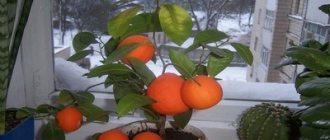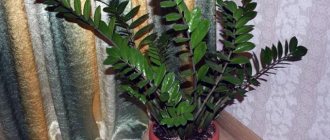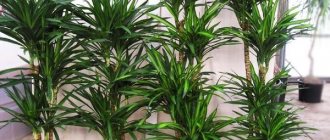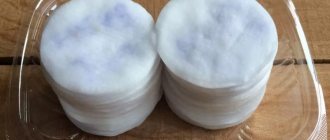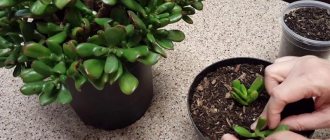Our advice will be useful to owners of Zamioculcas, as well as to those who are just planning to have a “money” pet. You will see that this plant does not require complex care. And we will tell you how to create favorable conditions for him.
Zamioculcas stands out among other indoor plants with its neat crown, impressive size and rich green color of leaves. But they love him not only for his spectacular appearance. There is a belief among flower growers that Zamioculcas helps its owners attract dollars. Therefore, along with the crassula (money tree), it took pride of place in many homes.
Meanwhile, not everyone knows how to properly care for a plant. Usually, it all comes down to the fact that Zamioculcas is unpretentious. But there are some features in caring for it.
Zamioculcas - description of the plant
Do you know plants such as monstera, dieffenbachia, syngonium or anthurium? So, Zamioculcas is a close relative of them and also belongs to the Araceae family. It began to be grown as a houseplant only at the end of the last century. And the wild relative of Zamioculcas, originally from tropical Africa, was first described in the first half of the 19th century.
Zamioculcas got its name from its resemblance to the Zamia plant from the cycad genus. By the way, zamia is common in America, on another continent, and it is also grown at home.
The common species in indoor culture is Zamioculcas zamiifolia.
Why did the plant attract flower growers so much? If you look at it carefully, you will notice that Zamioculcas is very unusual. Its thick stems are densely covered with glossy leathery leaves, sometimes resembling luxurious fans. The tubers of the plant are dense, but at the same time fragile. The dollar tree blooms very rarely and only in adulthood. The flower resembles an ear of corn, is rather inconspicuous and short-lived. So they grow the plant more for its greenery.
All parts of the plant are able to accumulate moisture, so Zamioculcas tolerates drought well. But the better the growing conditions of the flower, the juicier and brighter it will be.
Zamioculcas contains poisonous juice that can be dangerous for children, animals and allergy sufferers. When replanting, pruning, and propagating flowers, wear gloves. Make sure that the juice does not get on the skin and mucous membranes. In case of contact, rinse the affected area with plenty of water.
Kinds
Zamioculcas has many varieties, both natural and selected. Therefore, even experts cannot always understand the names and do not know which plant to classify as this genus. Which one is real?
Zamielifolia (Loddigeza)
The root is a tuber from which 60-centimeter leaf plates grow, divided into 4-6 pairs of individual feathers. The leaves fit tightly to each other, forming a rosette. During the dry season, the plant sheds its upper leaves.
Zamifolia
This species is called the “dollar tree”. Dissected leaves can reach 1 m, has a tuberous root. It looks great in the interior.
Variegated (variegated)
Some leaves on the bush are completely green, while others give the impression that they have not been painted. All of them are pointed at the tips. It has a root tuber and waxy leaf blades. It grows up to 1-1.5 m. The guest from Madagascar is quite rare in home collections, except that you can see it in botanical gardens.
Zamico
It was bred by breeders relatively recently. It is small in size and has small, oddly shaped leaves.
Lanceolate
It was precisely these elongated leaves that the ancestor of Zamioculcas had. Previously it grew up to one and a half meters in height. Now a miniature variety has been developed - about 60 cm.
Black
In appearance it resembles zamifolia. But it is interesting because it has very dark, almost black leaves and cuttings. While the bush is young, it has salad-colored leaves, but with age they darken more and more. This example looks quite impressive.
As you can see, Zamioculcas do not require careful attention; it is enough to provide them with the necessary temperature, lighting, and air humidity. And then the flower will delight with its beauty for a whole decade, or even more. And with the appearance of this succulent, prosperity will come to the house.
What to do with Zamioculcas after purchase
To preserve the decorative appearance of zamioculcas, you need to properly care for it from the moment of purchase. Despite the temptation to immediately transplant the plant into a beautiful flowerpot, do not rush, but let the flower get used to the new conditions. By the way, it is better to buy a plant in the warm season so that it does not freeze on the way home.
When the plant has settled into its new room, after about 2-4 weeks, you can carefully transfer it into the pot along with the old lump of earth, and fill the gaps with fresh soil. This will reduce the stress of the procedure.
Choose a pot for transferring according to the size of the plant. The diameter of the new container should be 3-4 cm larger than the previous one. Ceramic and clay pots are suitable. It is better not to use plastic ones, because... the roots of the plant can break through them. The ideal shape of the pot is narrowed downwards. The container must have holes for water drainage.
Some gardeners, on the contrary, prefer plastic containers, because it is difficult to remove the plant from ceramic ones in the future. If you also love plastic pots, feel free to use them for transfer. Just make sure that the plant does not grow too much, and carry out a new transshipment in time.
In order for the dollar tree to recover faster after transplantation, adhere to the following rules:
- use light and fertile soil;
- be sure to make drainage using expanded clay, clay shards or broken bricks;
- do not bury the roots completely into the soil; they should protrude about 1 cm above the soil surface;
- do not shake off the soil from the earthen clod.
Be sure to wear gloves while working, as... Zamioculcas juice is poisonous.
The plant cannot be watered immediately after the procedure, otherwise it will die. Do this after about 7-10 days, when the zamioculcas adapts to the new pot. The first watering should completely wet the earthen ball. Drain the water that has drained into the pan. Next time, water the flower when the soil dries well.
Reviews from flower growers
And I had such a story. My first “castle” grew in a plastic pot, so small that when it was without watering it could collapse at the slightest touch - it was tall. I then watched a program with Pavel Lobkov, where he cheerfully talked about how, having returned from a business trip, he discovered that the pot with his zamioculcas had practically exploded - so the roots were bursting from the inside! In short, I rushed to replant my specimen - and its pot allowed me to feel every potato - all lumpy! Transplanted... Time passed and he died. The large pot was not to my liking. I only saved a couple of twigs... The moral of this story is: the smaller the dish, the better!
Zmeulka
https://forum-flower.ru/showthread.php?t=174&page=5
https://www.woman.ru/home/medley9/thread/4519906/
This tree grows very slowly, so to make it lush, you have to work for many years... In about three years, I grew new stems, well, maybe 5-7, and several of them turned yellow and had to be cut off... For me, this is one of the most unpretentious growers; it doesn’t get offended if you forget to water it (by the way, on the contrary, it’s very afraid of overwatering). It’s standing next to the computer, it’s so green, even somehow dust doesn’t accumulate on it so quickly (or maybe it’s hard to see).
Karamellkka
https://forum.grodno.net/index.php?topic=158137.0
Mine (we've been growing together for two and a half years now) had stains when I bought it, but a year later new ones appeared. I dug it up and found dead roots, which, of course, I removed and replanted in a lighter soil, in the same pot. Now he feels great. There are no new spots. I'm inclined to think that they are simply filled in at the store. I also realized that he likes a period of relative rest (I water less and let the earthen coma dry out). During this time of relative rest, he feeds from his bulblets. I also noticed that he likes it when he sits shallow in the ground and the pot is too small for him.
Olga
https://www.flowersweb.info/forum/forum44/topic87929/messages/
If you know and take into account all the features of growing a dollar tree when caring, then it will turn out that growing this plant is quite easy, and it is very unpretentious. Perhaps the most difficult process in caring for it will be proper replanting, and, of course, moderate watering when caring.
Features of growing zamioculcas at home
The conditions for growing a dollar tree are quite simple. You will find basic information in our infographic. Save it so you always have it on hand!
Zamioculcas loves light and warmth, so it will feel good on western or eastern window sills and balconies. You can place the flower on the south side, but then provide it with good shading so that burns do not appear on the leaves. The plant will survive on a northern windowsill, in the shade, but may lose its rich green color. In summer he will enjoy “relaxing” in the garden or on the veranda. In winter, Zamioculcas often lacks light, so give it a place on the brightest windowsill.
Lighting
Zamioculcas has taken root well in Russia, but it will appreciate some reminders of the tropics.
- Choose a sunny window for a permanent location: south is ideal, west and east are acceptable.
Without sufficient lighting, Zamioculcas tends to stretch out and get sick, losing its decorative appearance in the struggle for light.
- Important: also avoid overheating when the leaves “burn” in very strong heat without ventilation.
In general, in nature, Zamioculcas often grows in rocky and mountainous areas, sometimes in forests, so shading, drought and any extreme changes are not fatal for it.
You can often see Zamioculcas as an outdoor plant decorating offices, reception areas, etc. A dollar tree, gradually accustomed to the shade, will live calmly even away from the window.
How to water Zamioculcas
Water zamioculcas sparingly. The main rule: it is better not to top up than to overfill. From spring to autumn, make sure that water does not stagnate in the pan. In winter, water the plant as the soil dries to avoid rotting of the tuber and roots. Water only with warm, settled water, because... Zamioculcas does not like cold or even cool temperatures.
Despite the fact that zamioculcus stores water, you should not overdry it, otherwise the plant will shed its tops and lose its decorative appearance. Prolonged dryness can also cause spider mite infestation.
Wipe off dust on the leaves with a cloth as needed or give the zamioculcas a warm shower once a month.
As for spraying, it can only be carried out at very high air temperatures. The rest of the time, it is not advisable to do this, so as not to provoke yellowing of the leaves. To increase humidity, it is better to spray the air around the flower or place a container of water next to it.
How to feed Zamioculcas
The dollar tree quickly takes nutrients from the soil and will respond gratefully to regular feeding. During the growth period, from April to September, 1-2 procedures per month are sufficient. From October to March there is no need to fertilize the plant. The basic rule of fertilizing is the same as when watering: less is better than more.
Use ready-made store-bought preparations, for example, universal ones or for cacti and succulents. For Zamioculcas, half the concentration of the solution is enough. Water at the roots. You can also spray the flower with a urea solution (1 g per 1 liter of water) once a month.
If you have just transplanted a young plant, do not feed it until new leaves appear.
Temperature
The tastes of Zamioculcas coincide with ours: a temperature of 22-25 degrees is the most acceptable.
- How to care for Zamioculcas during the dormant period? Not everyone removes the plant for the winter, but in general this is considered correct. If you decide to follow this advice, place the plant for the winter in a cool, ventilated room (16 degrees is optimal).
Photo of Zamioculcas in the interior of the balcony
How to trim zamioculcas
flowers.bitrix.ru
Despite its slow growth, zamioculcas requires regular crown formation and thinning. Otherwise, some of the leaves will not receive enough light and will turn yellow. Bare branches will not add decorative value to the flower. And if you prune regularly, you will get a luxurious green decoration for your interior.
Carry out pruning in spring or summer, but not in winter, when the tree has a dormant period. Dry and diseased parts of the plant, thickening stems and individual leaves must be removed. When replanting, also trim off some of the roots.
To work, you need a disinfected sharp pruning shears or a short knife. Scissors will not work because... they dampen the plant tissue. After the procedure, dry the sections and sprinkle with crushed coal.
When removing stems, leave the stumps near the surface of the soil, do not break them out, otherwise you will damage the tuber and roots. You can remove these stumps the next time you transplant and divide the zamioculcas.
Humidity
Zamioculcas itself is able to retain moisture in its fleshy leaves and does not need air humidification and spraying too much. Perhaps he will only need spraying and a shower in hot and stuffy weather (during a shower, the pot should be covered with a bag).
- But periodically wiping the leaves from dust is a good idea. Any soft fabric and your accuracy will do for this (leaves can easily be torn off if you pull).
How to transplant Zamioculcas
nasotke.ru
Like any other indoor plant, the dollar tree also needs to be replanted regularly. Young specimens are replanted annually, adults - as the roots grow, once every 3-4 years. As soon as they appear from the drainage holes, it’s time to transplant. If the plant is very old and large, it is enough to replace the top layer of soil with fresh one once a year. But this must be done carefully so as not to damage the root system.
The ideal time to transplant zamioculcas is spring. But if necessary, work can be carried out at other times of the year.
Dollar tree tubers are fragile, so replanting most often involves transshipment along with an earthen lump. Make up the rest of the soil from equal parts of turf, leaf, peat soil and sand. If possible, add humus. Choose a pot 3-4 cm wider than the previous one. Be sure to do drainage.
The procedure for transplantation is as follows:
- put on household gloves (you remember that zamioculcas juice is poisonous!);
- carefully remove the plant and inspect the roots;
- cut off the soft rotten parts of the roots with scissors;
- if the bush has grown greatly, divide the tubers and plant them in different containers, thereby rejuvenating the plant;
- remove stumps remaining after pruning;
- pour soil into the bottom of a new pot and place a flower in it;
- fill the gaps between the walls of the pot and the plant, compact the soil;
- do not bury the tubers too deeply, let them protrude about 1 cm above the soil surface;
- do not water the plant for 7-10 days, then water so that the entire earthen ball is saturated with water, and drain the excess water from the pan.
After transplantation, the dollar tree needs time to adapt. Since the flower is already growing slowly, its development will slow down even more after the procedure, but don't worry. Soon the zamioculcas will get used to the new conditions and will definitely produce new leaves.
When to replant
There is no need to rush to replant Zamioculcas immediately after acquisition.
When purchasing, it is not always possible to identify diseases and traces of pests, so the plant should be isolated from other indoor flowers.
On average, quarantine lasts no more than 3 weeks—during this time, the health status of the crop can be determined.
It is recommended to water the plant during this period only as needed.
After the specified period, they are moved to new soil.
The old one is not suitable for the active development of exotics; it is considered transportable and does not contain the necessary nutrients. In addition, it does not allow moisture to pass through well, which can lead to rotting of the root system.
It is preferable to carry out the procedure in the spring, but if the purchase was made at another time of the year, you do not need to adhere to this rule.
There is no need to worry about the fact that Zamioculcas is blooming at this moment. The buds will most likely fall off, which will not cause any harm to the plant; on the contrary, it will give strength for a gentler adaptation. The next stage will come in due course.
How to propagate Zamioculcas
youtube.com
Zamioculcas can be propagated by any vegetative method: dividing the bush, cuttings or leaves. There is also a method of propagation by seeds, but it is rarely practiced in indoor floriculture. The easiest way to divide a dollar tree is when replanting. It will take a little more time to root the cuttings.
You can also take a healthy shoot that remains after pruning for propagation. Place it in water, wait for roots to appear, and then replant it in soil.
The most difficult method is leaf propagation, because... It will take about a year for new leaves to appear. After separating the leaf from the trunk, place it in a glass with wet sand and cover it with a transparent container, making a greenhouse. During this period, the leaf should grow roots. As soon as they appear, replant it in the soil and wait for new leaves to appear.
Soil selection
Although the dollar tree is considered unpretentious, there are still some peculiarities when planting.
The flower will die if you choose the wrong soil for it. He does not like ordinary nutritious black soil; the main quality of soil for this plant is breathability.
To transplant zamioculcas yourself, you will need special soil and expanded clay.
If the soil tends to accumulate moisture , the roots will simply rot, and the dollar tree will get sick and die .
The soil used for growing cacti . The plant will also take root well in universal soil for indoor plants, half mixed with river sand .
But you can create suitable soil yourself by mixing the following ingredients in equal parts:
- leaf soil;
- turf soil;
- peat;
- coarse river sand (without clay impurities).
It is recommended to keep it in a hot oven for 15–20 minutes . This procedure will rid the earth of harmful bacteria and fungal infections.
Diseases and pests of Zamioculcas
vosaduly.ru
Zamioculcas is a very hardy plant, so diseases and pests rarely affect it. Most often, the cause of the problem is incorrect agricultural practices (for example, if you watered the plant too often) or unfavorable external factors (if the dollar tree spent the whole summer in the garden and became infected with pests from other crops).
If you notice changes in the appearance of the flower in time, it can still be saved. Try to regularly inspect the leaves of Zamioculcas, they will tell you if something went wrong. The most common problem is yellowing of dollar tree leaves. We have collected the reasons and ways to solve it in one table.
| Why do Zamioculcas leaves turn yellow? | What to do |
| Overmoistening of the soil (leaves turn yellow and then brown, roots soften) | Urgently replant the plant in fresh soil. First remove all rotten parts and treat the cuts with crushed coal or a weak solution of potassium permanganate |
| Overhumidification of the air | Stop spraying, regularly ventilate the room or move the flower to another room |
| Temperature changes (root shoots also rot and dry out) | Treat with Kornevin. If the room temperature is low, protect the plant from drafts; if the room temperature is high, place a container of water next to the pot. |
| Lack of fertilizing | Gradually introduce fertilizing with ready-made preparations, for example, Agricola fertilizer. Just do not exceed the dosage, otherwise the condition of the weakened plant may worsen |
| No trimming | Trim overgrown side shoots and remove yellow leaves. Transplanting the plant into a larger pot and regular feeding will also help. |
The lower leaves of an adult zamioculcas turn yellow and die over time. This is a natural aging process, so there is no need to worry.
One of the reasons for yellowing leaves may be the presence of pests: aphids, spider mites, mealybugs or scale insects.
If you find pests on Zamioculcas, immediately isolate it from other indoor plants to avoid a massive epidemic.
When growing zamioculcas, you may encounter other problems. For example, spots on the leaves indicate that the plant was overcooled in a draft or received sunburn. It is enough to remove aggressive environmental factors, and Zamioculcas will feel better.
If the stem begins to rot, the plant is overwatered and its tubers are most likely very badly damaged. In this case, you will have to throw it away, but you can still try to root the living leaves from the top and grow a new zamioculcas.
If the zamioculcas has lost its aerial part, do not rush to throw it away. Inspect the tuber, and if it looks good, soak it in a weak solution of potassium permanganate and plant it in fresh soil. The plant will probably survive and send out new shoots. The main thing is not to water it too often and protect it from drafts.
Reproduction methods
There are several ways in which a plant can be propagated.
Leaf
To begin with, we remind you that a Zamioculcas leaf is the entire branch with leaf blades. The leaf length can reach 60 centimeters or more, which complicates the rooting process. For this purpose, it is best to take a small young leaf.
- Dry the cut leaf for several hours (you can even leave it for a day).
- Treat the sections with crushed activated carbon or Kornevin, a growth stimulant.
- We plant the leaf either in a cactus substrate or in a mixture of sand and vermiculite.
- We water by spraying 2 - 3 days after planting. The ground and the leaf itself should be sprayed.
- After 2–3 months, a nodule with white roots appears underground.
- New leaves should begin to grow within 7 months.
For propagation, select a small leaf
Leaf plate
Do not use old or too young leaf blades for propagation.
- Cut off the leaf blades selected for rooting.
- Leave for several hours to allow the cut areas to dry.
- Dip the dried cut into Kornevin, Zircon or into a mixture of one of the preparations with crushed activated carbon.
- Bury the prepared leaf plate 1/3 into the prepared moist substrate. For these purposes, you can use cactus soil, a mixture of peat and sand, or a mixture of vermiculite and sand.
- Place in a warm, bright place. You can cover the container with rooting plates with a mini-greenhouse, ventilating it from time to time.
- Gently moisten the soil with a spray bottle 2 to 3 days after planting. If you covered the container with a greenhouse, then carefully monitor the soil moisture level. Condensation collects in the greenhouse and it is not worth spraying the substrate frequently.
- After 1 - 2 months, nodules will appear.
- The first leaves may appear after 8 months or a year.
Propagation using a leaf blade is not the fastest method, but it is reliable. The smaller the planting material, the longer you will have to wait for sprouts.
The tuber will appear in 1 – 2 months
Using cuttings
Another reliable method. From one adult leaf you can get a sufficient amount of planting material.
- Cut the selected leaf just above ground level.
- Cut into cuttings. Each should have 2 sheet plates located opposite each other. The apical cutting must have at least 3 plates.
- Give the cuttings a few hours to dry.
- Dip the lower tip of the cutting into crushed activated carbon or into a root growth stimulator - Kornevin.
- Cuttings should be planted in cactus substrate with the addition of vermiculite.
- The cuttings take root very well, so you can plant them in separate small pots. You can place the cuttings in a greenhouse.
- After 2–3 days, the cuttings are sprayed with a spray bottle.
- Nodules will appear in 1 – 2 months.
- Young plants will begin to appear in 5 – 6 months.
Rooted apical cuttings
Do not take too young leaves for cuttings. They have little accumulated nutrients.
Division of an adult Zamioculcas
This is a very simple, fast and reliable method of division. You can divide the bush during a planned transplant.
- Carefully remove the bush from the pot.
- Free the root from the soil.
- Divide, being careful not to damage the tubers, into the required number of parts, separating the tangled roots with your hands. Each tuber must have buds from which side shoots will develop.
- If the root is damaged, you need to dry it for several hours and then sprinkle it with crushed activated carbon.
- Plant the plant in the prepared pot using cactus substrate. Don't forget about drainage.
- You can water it after 3 days using a spray bottle.
- Care for them in the same way as for an adult plant.
Dividing an adult plant into the required number of parts
After dividing the zamioculcas, the plants are planted in pots corresponding to the size of the rhizome.
Reproduction in water
This is a controversial method. Although some claim that they were able to root Zamioculcas in water.
- Cut off a leaf or half a leaf of the plant.
- Treat the edge with Kornevin or Heteroauxin for better rooting.
- Place in a container with water.

